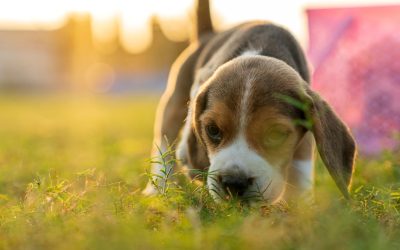When we bring home a new puppy, it’s natural to start with fun and simple tricks like “sit” and “paw.” While these are entertaining and build a good communication foundation, other skills are far more critical to your puppy’s development. Taking advantage of your puppy’s early socialization period—when they’re most open to learning and excited for new experiences—is critical to setting them up for a lifetime of confidence and good behavior.
Here are four things to teach your puppy before “paw.”
1. How to Politely Greet People and Dogs
Puppies are excited social butterflies, often eager to run up to every person or dog they see. While it’s tempting to let them indulge in their curiosity, this habit can lead to leash pulling, overexcitement, or even frustration when greetings aren’t possible. Teaching your puppy how to greet politely is a skill that will pay off immensely as they grow in size.
Start by practicing calm behavior when meeting others. Use space and reinforcers to help your puppy get into a sit or wait position before allowing them to say hello. Reward calmness with treats and praise, and always supervise interactions to ensure they’re positive and appropriate. Not only does this teach your puppy manners, but it also prevents future behavioral challenges, and awkward experiences with people and dogs when out and about.
2. How to Ignore People, Dogs, and Things
While polite greetings are essential, teaching your puppy that not every person, dog, or object needs their attention is equally critical. A dog that can focus on you and remain calm despite distractions is much easier to train and handle in distracting environments.
Start by rewarding your puppy for checking in with you when they notice something interesting, like a jogger or another dog. Gradually increase the level of distractions, consistently reinforcing calm behavior and reassurance. This skill helps prevent pulling, lunging, or barking at things in the future, ensuring your puppy learns to prioritize your guidance over their impulses.

3. How to Do Nothing
Yes, teaching your puppy to do nothing is a real thing—and it’s an invaluable skill that will bring you peace of mind! Puppies are bundles of energy, constantly on the move, and often getting into mischief when left to their own devices. Teaching them to relax and settle on a mat or designated spot can save you endless frustration and help them develop self-control and confidence.
Use positive reinforcement techniques to shape this behavior. Start by rewarding your puppy for lying calmly on a mat or bed. Gradually increase the duration and add distractions over time to test them. This teaches them that being calm and still is rewarding and prevents undesirable behaviors like chewing, excessive barking, or jumping.
4. New Things Don’t Need to Be Scary
The world can be overwhelming for a young puppy, so it’s essential to expose them to new experiences in a way that builds their confidence. Introduce them to various surfaces, people, animals, sounds, and scents, pairing each new experience with positive reinforcement like treats or play.
For example, when encountering a new surface like grass, tile, or sand, encourage your puppy to explore and reward them for bravery. Similarly, expose them to different sounds—like vacuum cleaners or car horns—at a low intensity, gradually increasing as they grow comfortable. This careful, positive exposure helps your puppy develop resilience and adaptability, allowing them to handle life’s surprises confidently. It will also bring you more confidence and ease when entering new environments with your dog instead of fear and anxiety.
For a comprehensive list of things to expose your puppy to, check out our blog on “101 Things to Expose Your Puppy To.”
How We Can Help
These four things to teach your puppy before paw can significantly benefit you and your pup for the rest of their life. Focusing on these essential behaviors before teaching tricks like “paw” will prepare your puppy for long-term success and excellent manners. Training isn’t just about commands—it’s about building a confident, well-mannered companion who thrives in your life and the world around them.
At Where Sit Happens, we’re here to support you and your puppy every step of the way. Whether you’re looking to join a group class or prefer private lessons tailored to your specific needs, our training programs are designed to help you build a strong foundation of skills.
Let’s help your puppy become the best version of themselves. Contact Where Sit Happens to learn more about our training programs!





0 Comments